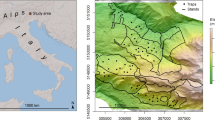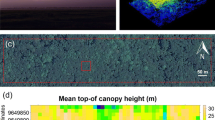Abstract
We aimed to identify microtopographical variation within a mangrove system in Southeast Queensland, Australia, at a detailed scale relevant to mapping immature mosquito habitat structure. Until recently, a lack of high-resolution elevation data has prevented detailed analysis of microtopography. This study used a LiDAR (Light Detection And Ranging) digital elevation model to identify microtopography within the mangrove system. There were two basin types, based on elevation relative to the average basin elevation (ABE). Elevation was measured in 10 m segments on transects. The segments were classified into prime and sub-prime habitats based on their suitability for immature mosquitoes: prime habitats were higher than the ABE, and sub-prime habitats were lower than the ABE. The coefficients of variation and elevation ranges gave a measure of microtopographic variability and the analysis showed that the two habitat types differed significantly both in mean elevation and microtopographic variability. This was related to conditions necessary for immature mosquito success. The use of LiDAR for mapping microtopography within mangrove forests demonstrated in this study has potential application in mosquito management, as microtopography appears to be a critical factor for suitable immature mosquito habitat and a better understanding of this may help managers to mitigate mosquito-borne disease.




Similar content being viewed by others
References
Anthony EJ (2004) Sediment dynamics and morphological stability of estuarine mangrove swamps in Sherbro Bay, West Africa. Marine Geology 208:207–224
Anthony EJ, Dolique F, Gardel A, Gratiot N, Proisy C, Polidori L (2008) Nearshore intertidal topography and topographic-forcing mechanisms of an Amazon-derived mud bank in French Guiana. Continental Shelf Research 28:813–822
Cohen MCL, Lara RJ, Szlafsztein C, Dittmar T (2004) Mangrove inundation and nutrient dynamics from a GIS perspective. Wetlands Ecology and Management 12:81–86
Dahdouh-Guebas F, De Bondt R, Abeysinghe PD, Kairo JG, Cannicci S, Triest L, Koedam N (2004) Comparative study of the disjunct zonation pattern of the grey mangrove Avicennia marina (Forsk) Vierh. in Gazi Bay (Kenya). Bulletin of Marine Science 74:237–252
Dahdouh-Guebas F, Kairo JG, De Bondt R, Koedam N (2007) Pneumatophore height and density in relation to micro-topography in the grey mangrove Avicennia marina. Belgian Journal of Botany 140:213–221
Dale PER, Knight JM (2008) Wetlands and mosquitoes: a review. Wetlands Ecology and Management 16:255–276
Duke NC, Meynecke JO, Dittmann S, Ellison AM, Anger K, Berger U, Cannicci S, Diele K, Ewel KC, Field CD, Koedam N, Lee SY, Marchand C, Nordhaus I, Dahdouh-Guebas F (2007) A world without mangroves? Science 317:41–42
Gislason GM, Russell RC (1997) Oviposition sites of the saltmarsh mosquito, Aedes vigilax (Skuse) (Diptera: Culicidae), at Homebush Bay, Sydney, NSW—a preliminary investigation. Australian Journal of Entomology 36:97–100
James LA, Watson DG, Hansen WF (2007) Using LiDAR data to map gullies and headwater streams under forest canopy: South Carolina, USA. Catena 71:132–144
Kerridge P (1971) Aspects of the ecology and biology of the salt-marsh mosquito Aedes vigilax (Skuse). Dissertation, University of Queensland
Kitaya Y, Jintana V, Piriyayotha S, Jaijing D, Yabuki K, Izutani S, Nishimiya A, Iwasaki M (2002) Early growth of seven mangrove species planted at different elevations in a Thai estuary. Trees–Structure and Function 16:150–154
Knight JM (2008) Characterising the biophysical properties of a mangrove forest to inform mosquito control. Dissertation, University of Queensland
Knight JM, Dale PER, Phinn SR (2005) Ochlerotatus vigilax breeding within mangrove basin forests: informatin requirements for TIR remote sensing. Arbovirus Research in Australia 9:179–183
Knight JM, Dale PER, Dunn RJK, Broadbent GJ, Lemckert CJ (2008) Patterns of tidal flooding within a mangrove forest: Coombabah Lake, Southeast Queensland, Australia. Estuarine, Coastal and Shelf Science 76:580–593
Knight JM, Dale PER, Spencer J, Griffin L (2009) Exploring LiDAR data for mapping the micro-topography and tidal hydro-dynamics of mangrove systems: an example from southeast Queensland, Australia. Estuarine, Coastal and Shelf Science 85:593–600
Komiyama A, Santiean T, Higo M, Patanaponpaiboon P, Kongsangchai J, Ogino K (1996) Microtopography, soil hardness and survival of mangrove (Rhizophora apiculata BL) seedlings planted in an abandoned tin-mining area. Forest Ecology and Management 81:243–248
Lara RJ, Cohen MCL (2006) Sediment porewater salinity, inundation frequency and mangrove vegetation height in Bragança, North Brazil: an ecohydrology-based empirical model. Wetlands Ecology and Management 14:349–358
Lim K, Treitz P, Wulder M, St-Onge B, Flood M (2003) LiDAR remote sensing of forest structure. Progress in Physical Geography 27:88–106
Lugo AE, Snedaker SC (1974) The ecology of mangroves. Annual Review of Ecology and Systematics 5:39–64
Macnae W (1966) Mangroves in Eastern and Southern Australia. Australian Journal of Botany 14:67–104
Mitsch W, Gosselink J (2000) Wetlands. Wiley, New York
Patz JA, Epstein PR, Burke TA, Balbus JM (1996) Global climate change and emerging infectious diseases. Journal of the American Medical Association 275:217–223
Proisy C, Gratiot N, Anthony EJ, Gardel A, Fromard F, Heuret P (2009) Mud bank colonization by opportunistic mangroves: a case study from French Guiana using lidar data. Continental Shelf Research 29:632–641
Ritchie SA (1993) Aedes vigilax: the taeni of oz. Arbovirus Research in Australia 6:52–58
Ritchie SA, Addison DS (1991) Collection and separation of Aedes taeniorhynchus eggshells from mangrove soil. Journal of the American Mosquito Control Association 7:113–115
Ritchie SA, Addison DS (1992) Oviposition preferences of Aedes taeniorhynchus (Diptera, Culicidae) in Florida mangrove forests. Environmental Entomology 21:737–744
Russell RC (2002) Ross River virus: ecology and distribution. Annual Review of Entomology 47:1–31
Simard M, Zhang KQ, Rivera-Monroy VH, Ross MS, Ruiz PL, Castaneda-Moya E, Twilley RR, Rodriguez E (2006) Mapping height and biomass of mangrove forests in Everglades National Park with SRTM elevation data. Photogrammetric Engineering and Remote Sensing 72:299–311
Tong SL, Bi P, Hayes J, Donald K, MacKenzie J (2001) Geographic variation of notified Ross River virus infections in Queensland, Australia, 1985–1996. American Journal of Tropical Medicine and Hygiene 65:171–176
van Loon AF, Dijksma R, van Mensvoort MEF (2007) Hydrological classification in mangrove areas: a case study in Can Gio, Vietnam. Aquatic Botany 87:80–82
Watson JG (1928) Mangrove forests of the Malay Peninsula. Malayan Forest Records 6:1–275
Zhang KQ (2008) Identification of gaps in mangrove forests with airborne LIDAR. Remote Sensing of Environment 112:2309–2325
Acknowledgements
We thank the Mosquito and Arbovirus Research Committee (MARC) and the Tweed Shire Council for supplying the LiDAR data. We would also like to thank the Tweed Shire Council for access to the study site and assistance with site selection.
Author information
Authors and Affiliations
Corresponding author
Rights and permissions
About this article
Cite this article
Griffin, L.F., Knight, J.M. & Dale, P.E.R. Identifying Mosquito Habitat Microtopography in an Australian Mangrove Forest Using LiDAR Derived Elevation Data. Wetlands 30, 929–937 (2010). https://doi.org/10.1007/s13157-010-0089-8
Received:
Accepted:
Published:
Issue Date:
DOI: https://doi.org/10.1007/s13157-010-0089-8




